
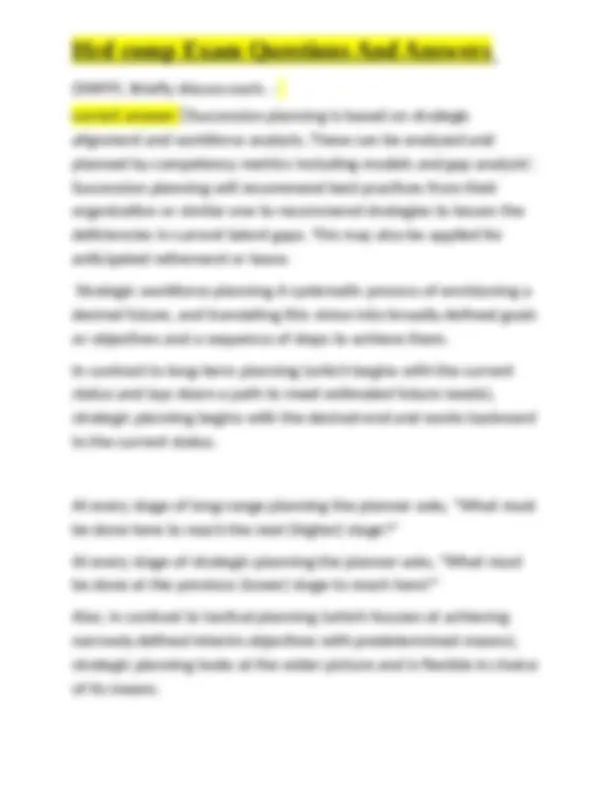
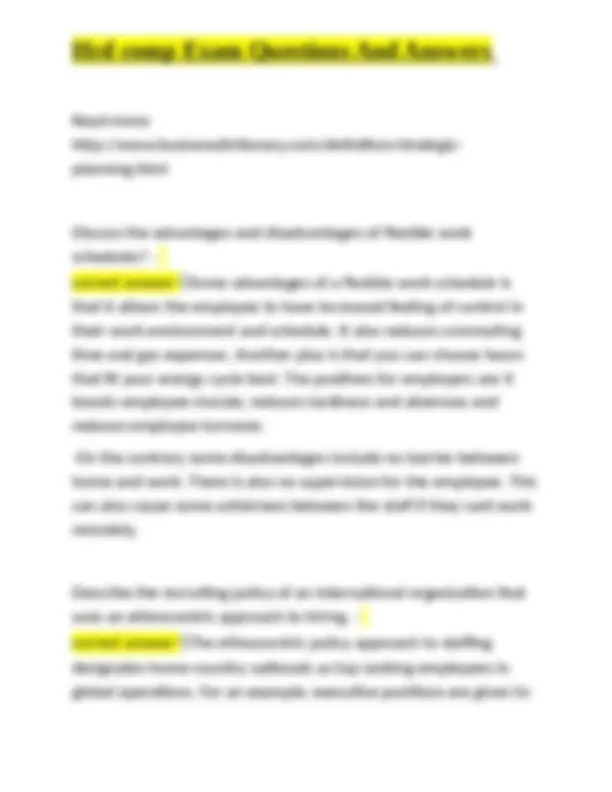
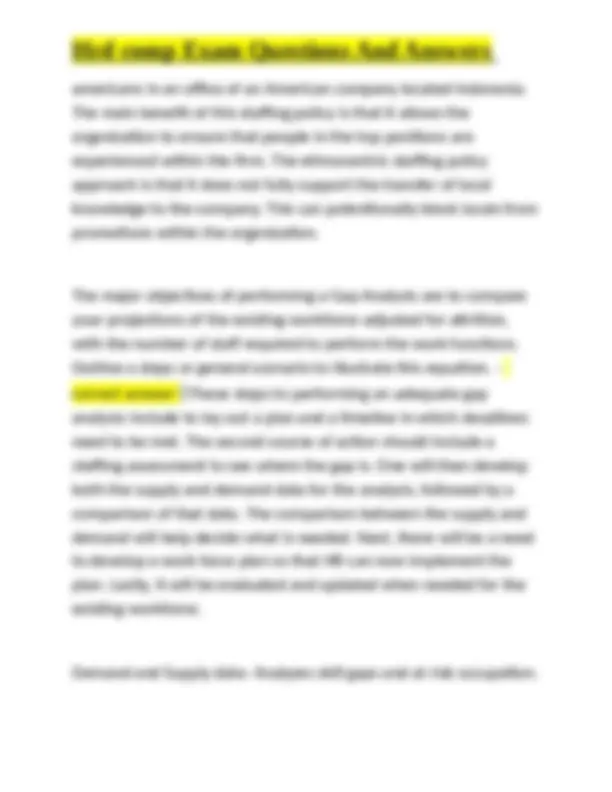
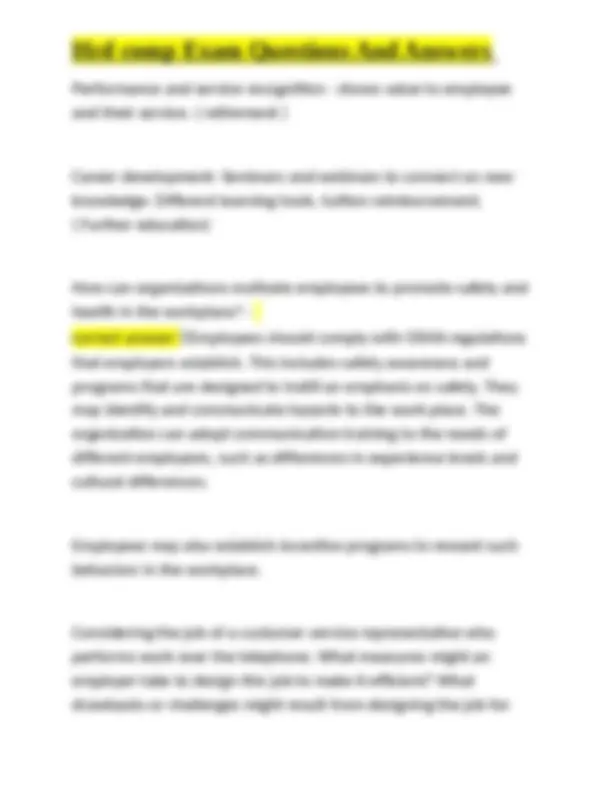
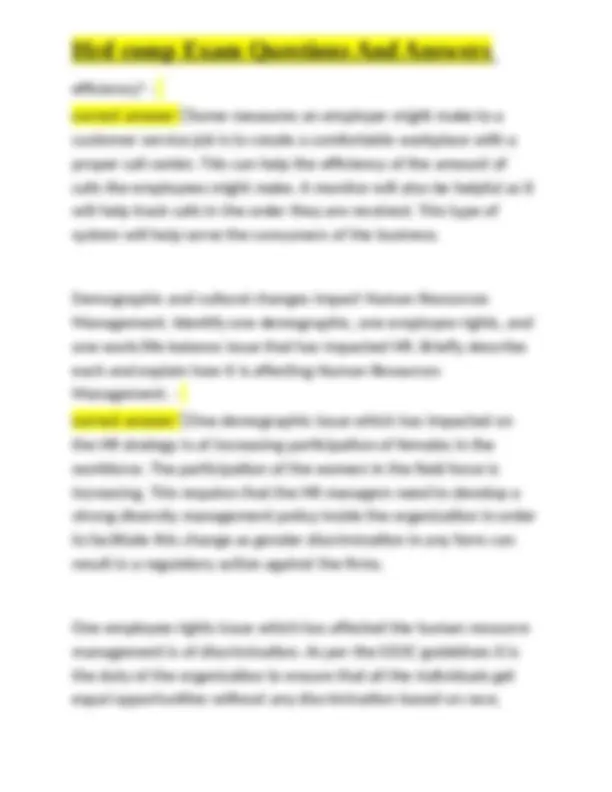
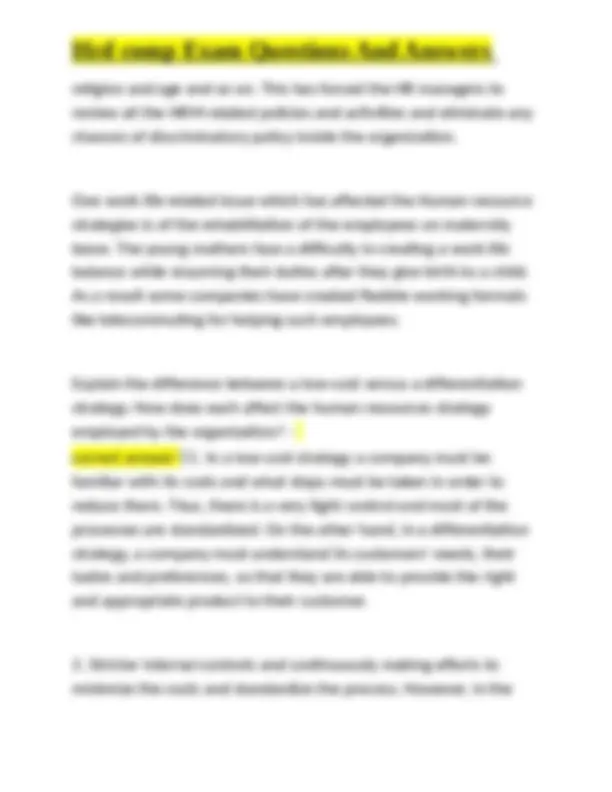
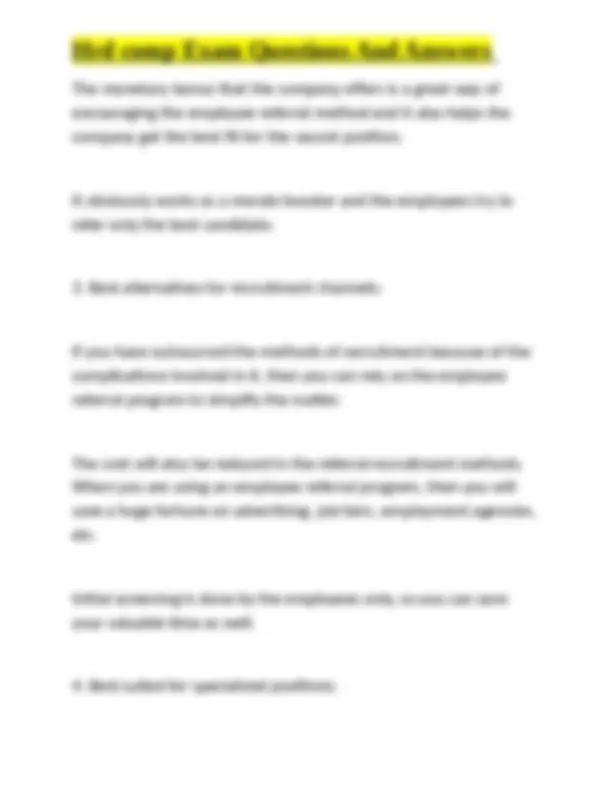
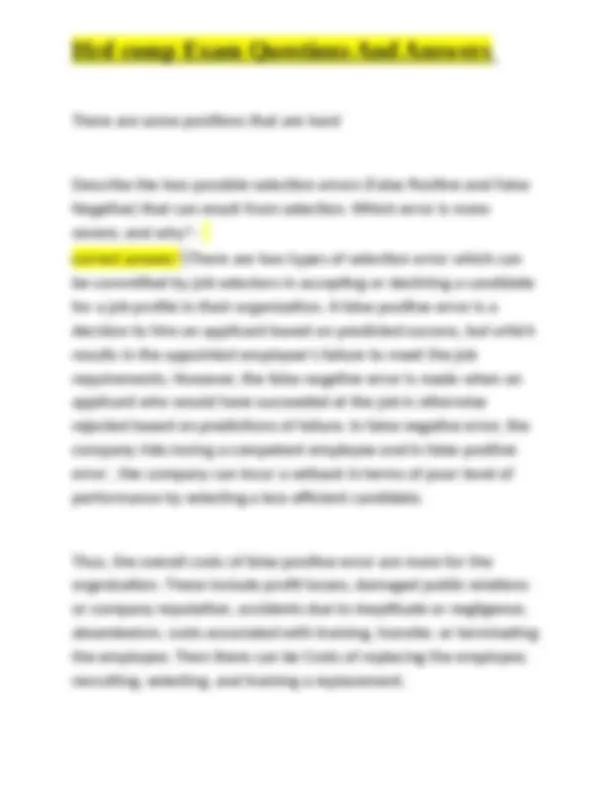
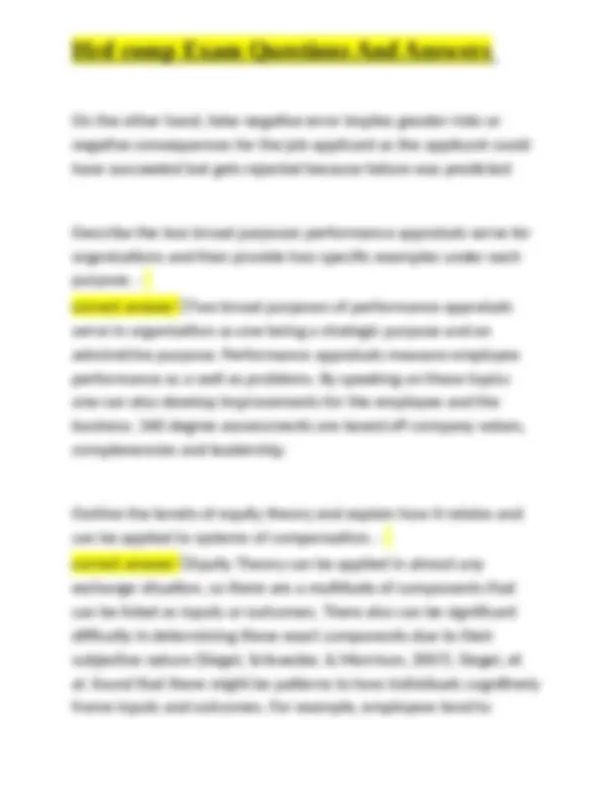

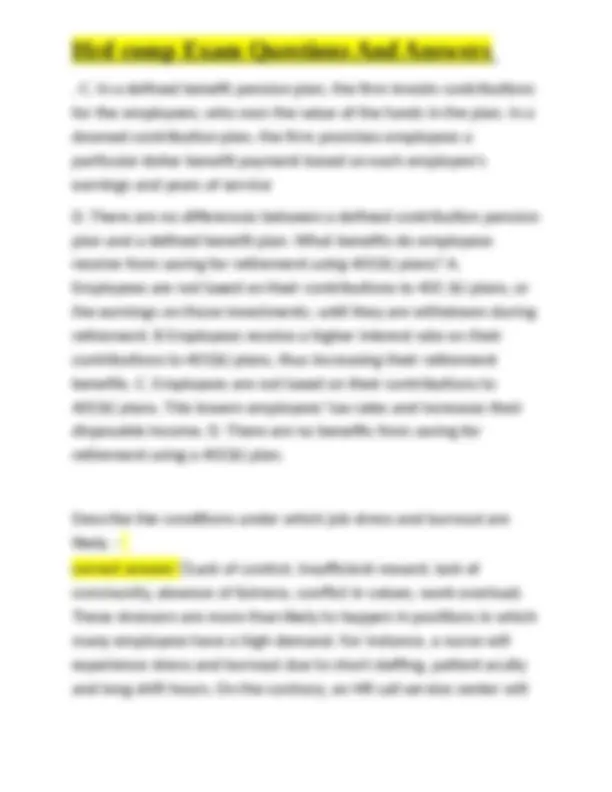



Study with the several resources on Docsity

Earn points by helping other students or get them with a premium plan


Prepare for your exams
Study with the several resources on Docsity

Earn points to download
Earn points by helping other students or get them with a premium plan
Community
Ask the community for help and clear up your study doubts
Discover the best universities in your country according to Docsity users
Free resources
Download our free guides on studying techniques, anxiety management strategies, and thesis advice from Docsity tutors
Hrd comp Exam Questions And Answers
Typology: Exams
1 / 20

This page cannot be seen from the preview
Don't miss anything!













There is a need for businesses to transfer knowledge from the baby-boomers who are retiring over the next decade or so to the millennials, who bring different talents and expectations. Describe how an organization can build a collaborative, knowledge sharing environment that supports both groups of employees. - correct answer ✅ANSWER- An organization first should develop talents from the baby-boomers and retain their strength has employees. There are many steps that can help support both groups of employees. They include retaining baby boomers as long as you can by offering the flexibility they may need. It is also important to value their expertise and knowledge as they may be in leadership roles. This knowledge transfer promotes opportunities that an organization can create. By tying these two together you can build a collaborative group of employees. What competencies are important for success in HR management?
correct answer ✅Leadership is an essential competency of an HR manager. HR managers are responsible for creating strategic plans for the HR department and the overall workforce. The leadership skills are critical to communicating changes throughout the department. Identify three key differences between traditional workforce planning (succession planning) and strategic workforce planning
Read more: http://www.businessdictionary.com/definition/strategic- planning.html Discuss the advantages and disadvantages of flexible work schedules? - correct answer ✅Some advantages of a flexible work schedule is that it allows the employee to have increased feeling of control in their work environment and schedule. It also reduces commuting time and gas expenses. Another plus is that you can choose hours that fit your energy cycle best. The positives for employers are it boosts employee morale, reduces tardiness and absences and reduces employee turnover. On the contrary some disadvantages include no barrier between home and work. There is also no supervision for the employee. This can also cause some unfairness between the staff if they cant work remotely. Describe the recruiting policy of an international organization that uses an ethnocentric approach to hiring. - correct answer ✅The ethnocentric policy approach to staffing designates home country nationals as top ranking employees in global operations. For an example, executive positions are given to
americans in an office of an American company located Indonesia. The main benefit of this staffing policy is that it allows the organization to ensure that people in the top positions are experienced within the firm. The ethnocentric staffing policy approach is that it does not fully support the transfer of local knowledge to the company. This can potentionally block locals from promotions within the organization. The major objectives of performing a Gap Analysis are to compare your projections of the existing workforce adjusted for attrition, with the number of staff required to perform the work functions. Outline a steps or general scenario to illustrate this equation. - correct answer ✅These steps to performing an adequate gap analysis include to lay out a plan and a timeline in which deadlines need to be met. The second course of action should include a staffing assessment to see where the gap is. One will then develop both the supply and demand data for the analysis, followed by a comparison of that data. The comparison between the supply and demand will help decide what is needed. Next, there will be a need to develop a work force plan so that HR can now implement the plan. Lastly, it will be evaluated and updated when needed for the existing workforce. Demand and Supply data- Analyzes skill gaps and at risk occupation.
Talent management strategy requires a strong investment in total rewards. Explain the elements of a total rewards program as part of a talent management strategy. Describe specific elements of a total rewards program and how each element serves HR and business strategy. - correct answer ✅Total rewards come with the idea of a collaborative benefit package. This can include many incentives which, can be a competitive salary. This component is what is usually very much important in a candidate's decision to join a new organization. The top five elements of total rewards is compensation, benefits, work life, performance and development ( career growth / opprtuntuties) Compensation- The pay should be competitive in the market and there should be added incentives. Benefits- Should include health and welfare plans. It should also have life insurance and pre tax benefits, disability plans and retirement. Work life benefits- flexible work schedules. Paid and upaid time off. Health and wellness initiatives as well as culture diversity program.
Performance and service recognition - shows value to employee and their service. ( retirement ) Career development- Seminars and webinars to connect on new knowledge. Different learning tools, tuition reimbursement. ( Further education) How can organizations motivate employees to promote safety and health in the workplace? - correct answer ✅Employees should comply with OSHA regulations that employers establish. This includes safety awareness and programs that are designed to instill an emphasis on safety. They may identify and communicate hazards to the work place. The organization can adopt communication training to the needs of different employees, such as differences in experience levels and cultural differences. Employees may also establish incentive programs to reward such behaviors in the workplace. Considering the job of a customer service representative who performs work over the telephone. What measures might an employer take to design this job to make it efficient? What drawbacks or challenges might result from designing the job for
religion and age and so on. This has forced the HR managers to review all the HRM related policies and activities and eliminate any chances of discriminatory policy inside the organization. One work life related issue which has affected the Human resource strategies is of the rehabilitation of the employees on maternity leave. The young mothers face a difficulty in creating a work life balance while resuming their duties after they give birth to a child. As a result some companies have created flexible working formats like telecommuting for helping such employees. Explain the difference between a low-cost versus a differentiation strategy. How does each affect the human resources strategy employed by the organization? - correct answer ✅1. In a low-cost strategy a company must be familiar with its costs and what steps must be taken in order to reduce them. Thus, there is a very tight control and most of the processes are standardized. On the other hand, in a differentiation strategy, a company must understand its customers' needs, their tastes and preferences, so that they are able to provide the right and appropriate product to their customer.
differentiation strategy - a company must continuously innovate to address the wants of its customer. Further, the company must even focus on its brand building process to create awareness about the brand within its customers minds.
Low-cost strategy example: Dell follows a low-cost strategy model and has been very successfull at it Many organizations rely on employee referral programs to identify prospective employees. What are the advantages and disadvantages of such an approach? - correct answer ✅Candidate quality will be better Wider candidate pool Hiring speed Boosts morale Cost Counter negative reviews Quicker onboarding Good candidate fit Better retention rate
The monetary bonus that the company offers is a great way of encouraging the employee referral method and it also helps the company get the best fit for the vacant position. It obviously works as a morale booster and the employees try to refer only the best candidate.
There are some positions that are hard Describe the two possible selection errors (False Positive and False Negative) that can result from selection. Which error is more severe, and why? - correct answer ✅There are two types of selection error which can be committed by job selectors in accepting or declining a candidate for a job profile in their organization. A false positive error is a decision to hire an applicant based on predicted success, but which results in the appointed employee's failure to meet the job requirements. However, the false negative error is made when an applicant who would have succeeded at the job is otherwise rejected based on predictions of failure. In false negative error, the company risks losing a competent employee and in false positive error , the company can incur a setback in terms of poor level of performance by selecting a less efficient candidate. Thus, the overall costs of false positive error are more for the organisation. These include profit losses, damaged public relations or company reputation, accidents due to ineptitude or negligence, absenteeism, costs associated with training, transfer, or terminating the employee. Then there can be Costs of replacing the employee, recruiting, selecting, and training a replacement.
distinguish inputs based on whether they are controllable or uncontrollable. Such as communications or attendance within controllable inputs, and seniority or job training within non- controllable inputs (Siegel, et. al., 2007). Employees also distinguish differing characteristics of outcomes (Siegel, et. al., 2007). Outcomes are evaluated on whether they are economic or noneconomic and whether they are personalized or generalized outcomes (Siegel, et. al., 2007). If managers can help prevent perceptions of inequality they can help prevent their employees from becoming de-motivated. Swinton (2006) developed a list of ways an employee can express motivation. This list is produced below Discuss the advantages and disadvantages of a compensation system based on straight salary versus straight commission for a sales position. Provide perspective from both the employers and employees. The primary reason companies use commission incentives is to motivate sales employees to work harder, more effectively or more efficiently to convert sales. The motivational impact can vary, but those salespeople driven by income tend to go after more prospects and work more diligently to get sales if pay is connected to success. Employees often take salary pay for granted. However, knowing that extra effort or results means more pay can motivate. - correct answer ✅Advantage: Pay Tied to Revenue
A financial advantage with commissions is that you know you only pay on sales conversions. Thus, you typically don't incur the commission costs unless you also get the revenue that comes with the sales. This factor is why many sales-intensive companies pay on straight commission. Managers can effectively control labor costs or ensure optimized selling efficiency by only paying workers for the results that they produce. Disadvantage: Unpredictable Expenses Naturally, a company that pays commissions would gladly incur high commission costs in exchange for strong revenue performance. However, the uncertainty with commission pay can lead to budget challenges, especially if you sell on account to buyers. If you pay commissions shortly after the purchase but don't collect payments for an extended period, you have a lack of alignment in revenue and compensation. Some salespeople also struggle with the uncertainty of a commission plan. Disadvantage: Overly Aggressive Sales The philosophical view or values of your business also dictate whether commissions make sense. Commission incentives sometimes motivate staff to use an overly aggressive approach to
. C. In a defined benefit pension plan, the firm invests contributions for the employees, who own the value of the funds in the plan. In a downed contribution plan, the firm promises employees a particular dollar benefit payment based on each employee's earnings and years of service D. There are no differences between a defined contribution pension plan and a defined benefit plan. What benefits do employees receive from saving for retirement using 401(k) plans? A. Employees are not taxed on their contributions to 401 (k) plans, or the earnings on those investments. until they are withdrawn during retirement. B Employees receive a higher interest rate on their contributions to 401(k) plans, thus increasing their retirement benefits. C. Employees are not taxed on their contributions to 401(k) plans. This towers employees' tax rates and increases their disposable income. D. There are no benefits from saving for retirement using a 401(k) plan. Describe the conditions under which job stress and burnout are likely. - correct answer ✅Lack of control, insufficient reward, lack of community, absence of fairness, conflict in values, work overload. These stressors are more than likely to happen in positions in which many employees have a high demand. For instance, a nurse will experience stress and burnout due to short staffing, patient acuity and long shift hours. On the contrary, an HR call service center will
experience the same feeling. This can be due to various things which include high volumes of calls, poor work settings and not enough resources.